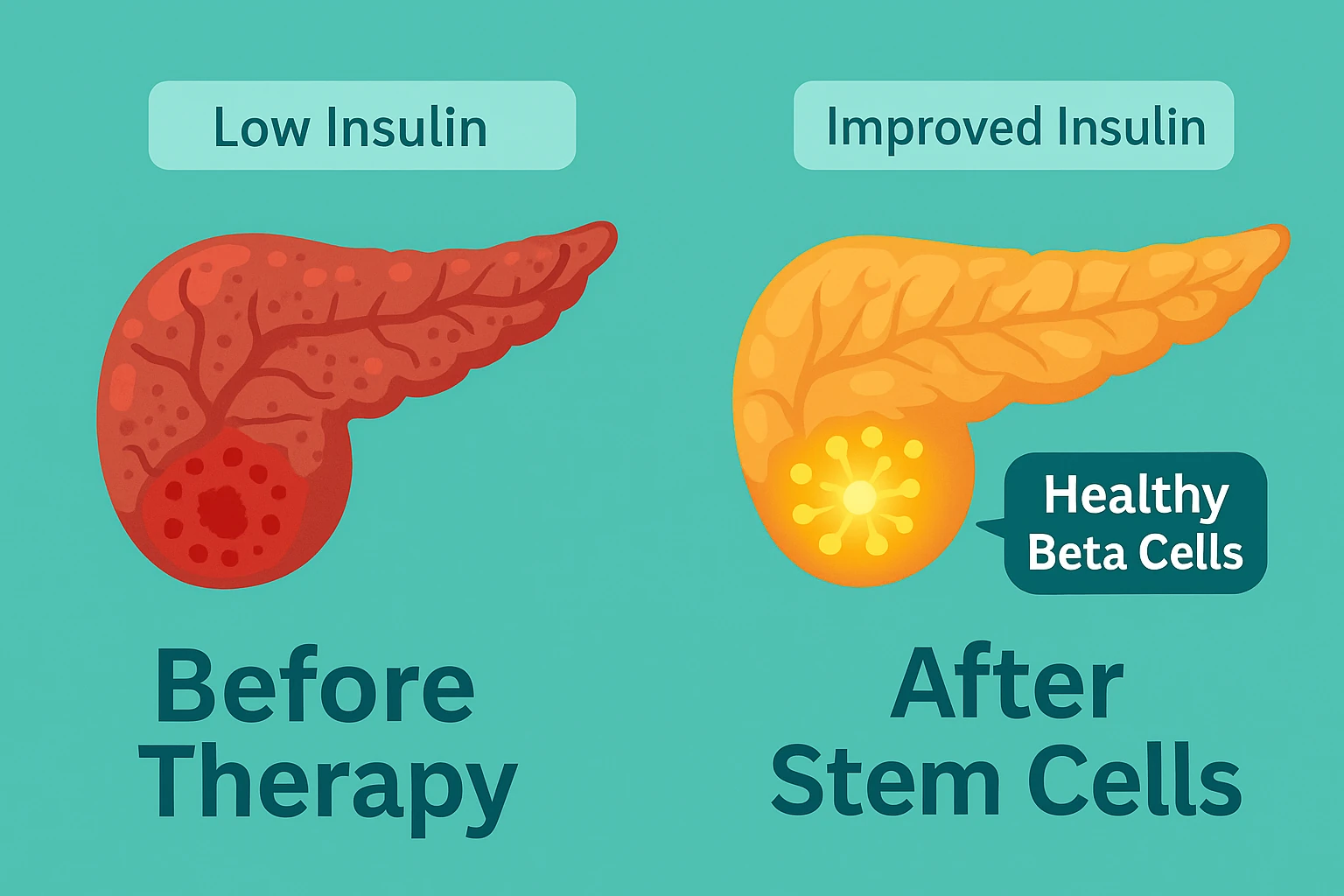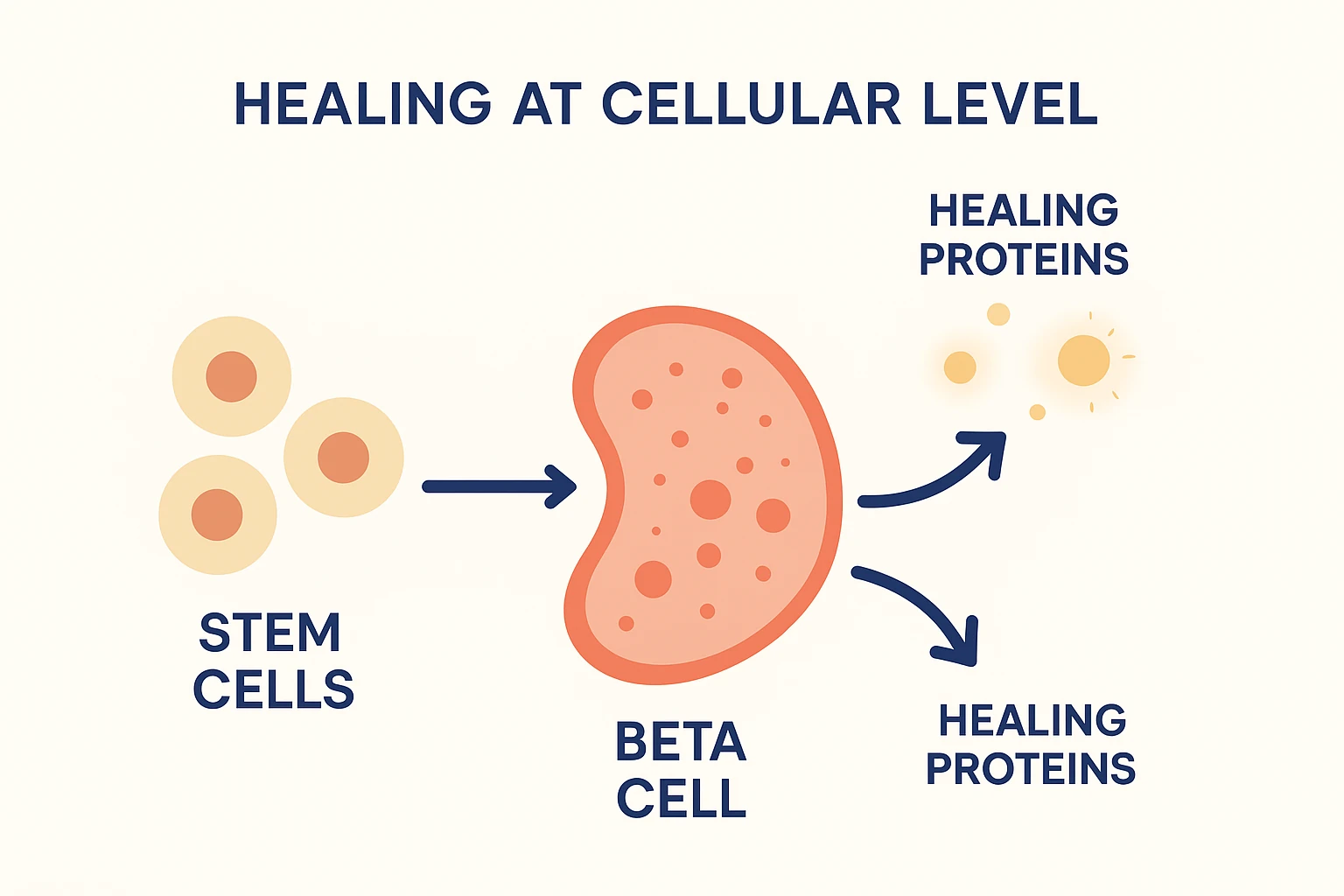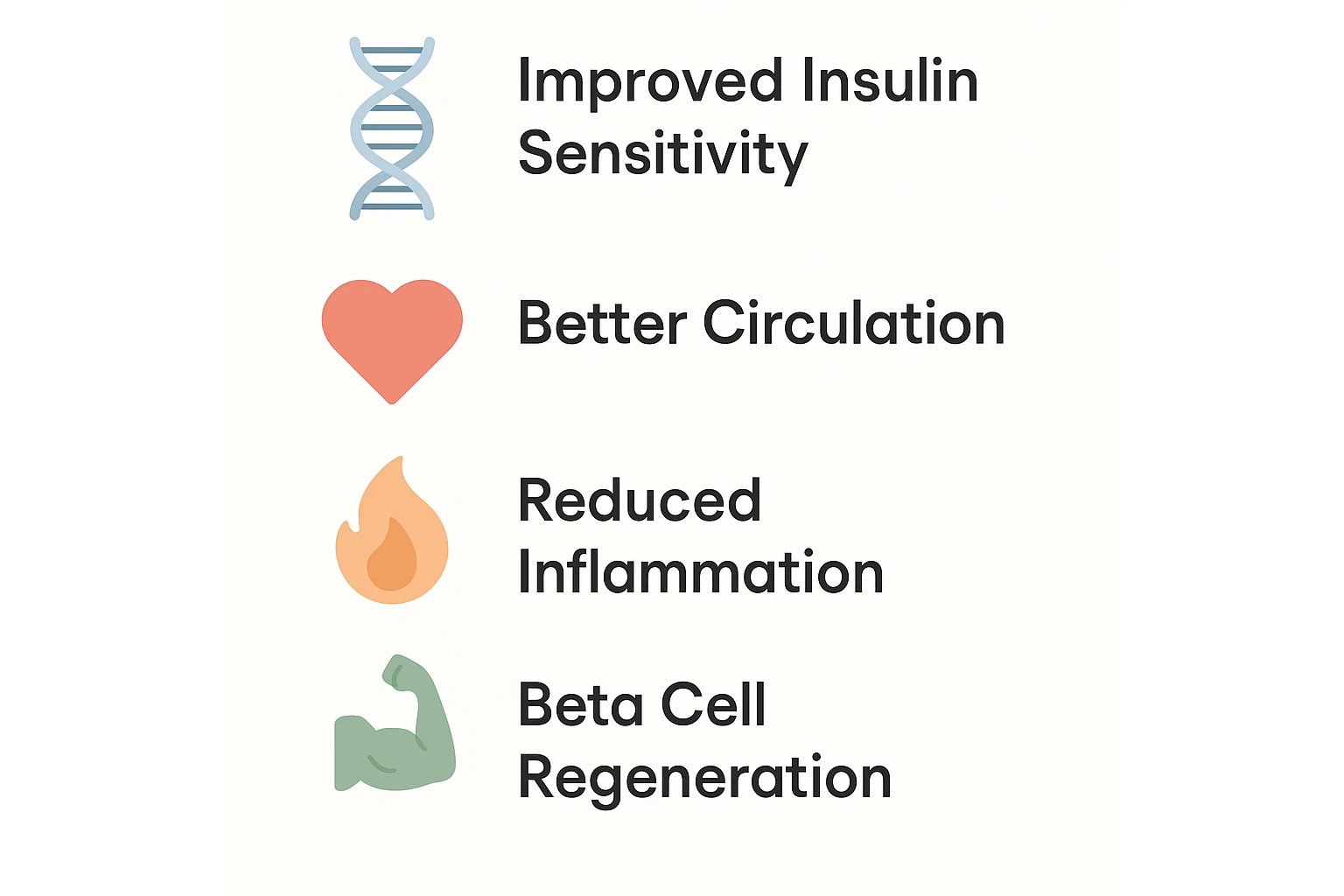Autoimmune
Stem Cell Treatment
Finding Relief from Type 2 Diabetes: Understanding Stem Cell Treatment for Diabetes Type 2
If persistent high blood sugar or type 2 diabetes has been limiting your daily activities, you might consider exploring stem cell treatment for diabetes type 2, a regenerative approach designed to improve insulin production, reduce insulin resistance, and restore blood sugar control. This treatment addresses various diabetes complications including fatigue, frequent urination, slow wound healing, nerve damage, and medication side effects.
Clinical studies show that many patients experience significant improvements, with research showing that about 2 out of 10 patients achieve excellent blood sugar control, and many reduce their insulin needs by 25-70%. Unlike treatments that only manage symptoms temporarily, stem cell therapy for type 2 diabetes works at the cellular level to support your body's natural insulin production and usage. In this comprehensive guide, we'll explore the science behind this treatment, what to expect during the process, and help you understand if this regenerative approach could be the key to reclaiming the active life you've been missing.
What Is Stem Cell Therapy for Type 2 Diabetes?
Stem cells function as your body's cellular reserve system. Unlike specialized cells that perform one specific job, stem cells remain undifferentiated until needed, then transform into whatever cell type your body requires. This remarkable ability makes them particularly valuable for treating metabolic conditions.
In diabetes stem cell therapy, we use carefully screened donor cells (mesenchymal stem cells) that have been extensively tested for safety and potency. When delivered through IV infusion, these cells respond to chemical signals from your pancreas and other affected tissues. They can support beta cell function, release anti-inflammatory compounds, and improve insulin sensitivity throughout your body. The process amplifies your body's existing repair mechanisms in the exact locations where healing is needed most.

The Natural Decline of Your Body's Repair System
Research shows that by age 35, you've lost approximately 5–10% of your original stem cell count. By age 50, you've lost around 30–50%. By age 70, you've lost about 70–90% of your original stem cell capacity. This steady decline parallels the increasing difficulty many people experience with blood sugar control as they age.
This helps explain why diabetes often develops in middle age and becomes harder to control over time. Your younger self had abundant cellular resources to maintain metabolic health. Your older self has significantly fewer healing cells available, which often means declining beta cell function and worsening insulin resistance.
The progressive loss of stem cells has a direct effect on metabolic health. Your pancreatic beta cells, which produce insulin, depend heavily on stem cells for maintenance and regeneration. When stem cell numbers drop too low, diabetes complications begin accumulating faster than your body can address them.
The Science of Stem Cells and Diabetes Type 2
When stem cells to treat diabetes type 2 are infused into your body, they immediately go to work through a sophisticated healing process. First, these cells detect inflammation in your pancreas and insulin-resistant tissues through special chemical messengers. This allows them to identify exactly where repairs are needed.
Understanding stem cells and diabetes requires knowing how these cells work differently than traditional medications. The stem cells then begin producing healing proteins and modulating your metabolism. Here's what they release:
Healing Proteins Released by Stem Cells

Complete Treatment Experience: What to Expect
The entire stem cell therapy procedure takes approximately 90-120 minutes per session. Unlike procedures that require surgery or complex preparation, our approach uses pre-screened donor cells, eliminating the need for extraction and processing time.
What to Expect During Your Stem Cell Infusion
Since we use donor mesenchymal stem cells, you won't experience the discomfort associated with bone marrow or fat tissue harvesting. The treatment involves IV infusion into your bloodstream. Most patients describe the sensation as similar to receiving IV fluids - you simply relax in a comfortable chair during the process. No anesthetic is needed.
The Steps Involved in Your Stem Cell Procedure
Here's exactly what happens during your treatment:
- Pre-treatment preparation: Medical team reviews your diabetes history and prepares the treatment
- IV placement: Standard IV line placed in your arm
- Stem cell preparation: 100-200 million mesenchymal stem cells prepared for infusion
- Infusion: Stem cells delivered through IV over 60-90 minutes
- Post-infusion care: Brief monitoring period to ensure you're comfortable before going home
To enhance results, we complement the stem cell treatment with:
- Customized anti-diabetic nutrition protocols
- Exercise and lifestyle modification guidance
- Blood sugar monitoring strategies
- Follow-up care and support
Recovery and Post-Treatment Care
Your recovery begins immediately after treatment. Here's what to expect:
First 48-72 hours: Some mild fatigue or low-grade fever is normal as your body responds to the stem cells. This actually indicates the healing process has begun. Continue your current diabetes medications as prescribed.
First week: Most patients return to normal activities within 2-3 days. Blood sugar levels may fluctuate initially as your body adjusts. Close monitoring is important during this period.
Weeks 2-4: Early improvements often begin, including better energy levels and more stable blood sugar readings. Many patients notice reduced medication needs under medical supervision.
Months 1-6: This is when significant metabolic improvements occur. Stem cells continue working to improve insulin production and sensitivity, with most patients experiencing progressive improvement throughout this period. Peak benefits often appear between months 3-6.
Investment and What's Included
Complete Treatment Package: USD$12,000 to USD$15,000
Your investment covers:
- Initial medical consultation and evaluation
- 100-200 million mesenchymal stem cells per infusion (2-3 infusions)
- Laboratory testing including HbA1c and metabolic panels
- The infusion procedures
- All medical supplies and monitoring equipment
- Personalized nutrition program for diabetes
- Exercise and lifestyle counseling
- 24/7 support during treatment period
Comparing Treatment Options for Type 2 Diabetes
Research on Stem Cell Therapy for Diabetes Success Rate
The scientific evidence supporting stem cell therapy for type 2 diabetes continues to grow stronger. Here's what the research shows in simple terms:
A large Chinese trial from 2022 studied 91 patients over 48 weeks. About 2 out of 10 patients achieved excellent blood sugar control (HbA1c under 7%) while cutting their insulin use in half. The average insulin reduction was about 28% compared to 16% in the placebo group.
Recent breakthrough cases from 2024 made headlines worldwide. A 59-year-old man in China stopped needing insulin completely after stem cell treatment. He now enjoys normal blood sugar without any diabetes medication - something doctors called a potential stem cell cure for diabetes, though more research is needed to confirm if this can work for everyone.
A comprehensive review from 2024 looked at over 260 diabetes patients across multiple studies. The results were consistent: most people saw improvements in blood sugar control, reduced medication needs, and better quality of life.
Analysis of worldwide trials found 143 different studies testing stem cells for diabetes. While most are still in early phases, the safety record is excellent with no serious side effects reported.
What This Means for You:
- About 6-7 out of 10 patients see some improvement
- Many can reduce diabetes medications by 25-70%
- Benefits typically start within 2-3 months
- Current studies show benefits lasting at least 12 months

Frequently Asked Questions
Can Stem Cells Cure Type 2 Diabetes?
While stem cell cure for diabetes type 2 is not yet proven, recent cases show remarkable promise. In 2024, doctors reported cases where patients significantly reduced or eliminated insulin needs after treatment. However, most patients experience improvements in blood sugar control rather than complete cure, with about 20% achieving target HbA1c levels under 7%.
How Effective Is Stem Cell Therapy for Type 2 Diabetes?
The stem cell therapy for type 2 diabetes success rate is encouraging, with studies showing 60-70% of patients experiencing meaningful improvements. About 2 out of 10 patients achieve excellent blood sugar control (HbA1c under 7%), and many reduce their insulin needs by 25-70%. Benefits typically begin within 2-3 months and can last for at least 12 months based on current follow-up data.
What Is Stem Cell Therapy for Diabetes Type 2?
Stem cell therapy for diabetes type 2 involves infusing mesenchymal stem cells through IV to improve your body's insulin production and usage. These specialized cells travel to your pancreas and other tissues, where they reduce inflammation, support beta cell function, and help your body respond better to insulin naturally.
Conclusion
Stem cell therapy for type 2 diabetes offers a treatment option that works with your body's natural healing processes. By supplementing your declining stem cell count and supporting pancreatic function, this approach addresses the underlying metabolic dysfunction rather than just managing blood sugar levels. The research shows positive outcomes, with the majority of patients experiencing improved glucose control and reduced medication dependence. While individual results vary, the combination of scientific evidence, minimal invasiveness, and excellent safety profile makes stem cell therapy an option worth considering for those seeking alternatives to escalating medication regimens. If you're interested in learning more about whether stem cell therapy is right for your diabetes management, contact us to schedule a consultation to discuss your specific situation and treatment options.
Individual results may vary. No treatment outcomes are guaranteed. This information is for educational purposes only and should not replace professional medical advice. Statements not evaluated by the FDA or COFEPRIS.
Treatment
- Medical consultation
- 300 million Stem Cell IV
- Super immune IV + NAD + glutathione + others as need
- Full blood panel
- Recommended supplement to take.
- Recommendation on things to do to enhance wellness.
